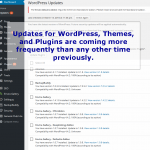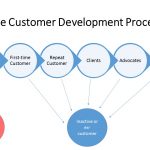Is a Lean and Mean HTML Website Better than a CMS Website?
I was asked this question by a client just the other day. He really wanted know which one is better, an HTML or CMS site. It seems obvious that the clear-cut best choice is a CMS website. But, why is it? I ask the question again, HTML vs CMS ?
I am putting on my thinking cap and articulating the difference of between the 2 methods of building a website to him. The final answer is it’s not that clear-cut. The conclusion is CMS sites provide greater value as the complexity of the website increases. For simple websites, the website designer’s expertise and client’s willingness to correctly update content plays heavily in determining the best choice for the client, whether it’s HTML or CMS site.
Content Management System, (CMS), Website
There are a huge number of websites built on Open Source frameworks using the most popular packages of: WordPress, Joomla and Drupal. There are also other frameworks such as MODx, e107, Mambo, XOOPS, PHP-Nuke and phpwcms. Just to clarify the definition of CMS site, CMS allows the client to log-in to the website to make changes to the content, as well as, to the website functions and structure. HTML site requires a client to hire programmer with skills in HTML, CSS, JavaScript, PHP and etc.
An estimated of 15% of the worldwide one trillion web pages are built with WordPress. Next in popularity is Joomla and followed by the techie’s delight, Drupal. I estimate 35% to 45% of websites are built on some kind of CMS framework that allows access to content to be updated. I believe CMS websites are the wave of the future.
There are many benefits provided by CMS that can’t be overstated or denied. A greater value is achieved by having a website built on an Open Source framework with a CMS interface for the client. This CMS log-in facility allows the client to update the site and refresh the content without having any programming skills.
Also, Open Source allows the client to own the intellectual property asset or more precisely to use the Creative Common license free of charge. The thousands of lines of quality code are written for each Open Source framework that is worth $100,000 or more. When you take into account the plug-ins or extensions constantly being released and improved, the value of CMS is tremendous. Open Source is a proven technical business model of extensive quality functionality that is available now and continues to grow in value for an unbeatable price – it’s free of charge. What you are paying a website designer for is not the software, but the services to assemble, integrate and organize the framework with content, template or theme and functions.
A remarkable benefit of CMS is the ability to fire your website developer or web programmer that you are dissatisfied with. This prevents a client from being locked into situation due to unique coding. You may seek out and retain a better website designer replacement. The resource pool with the necessary skills to build, maintain and improve CMS websites is plentiful. Since these Open Source frameworks are very popular, there are numerous classes, videos and books published and available through the Amazon, bookstores and public library to learn CMS. One last comment, a full-function CMS website with many extensions or plug-ins, would be outrageous expensive, if coded from scratch.
Lean and Mean HTML Websites
Building a website with HTML and CSS is analogous to building a house with basic material components such as assorted lumber, plywood, sheet-rock, nails and cement block and etc. In contrast, building a CMS site is like building a house with modular components, such as pre-constructed roof, pre-assembled walls and floors, complete bathrooms and a full kitchen. The HTML sites can be designed starting with a blank sheet of paper, while the CMS site is already designed and may be installed as a framework in a matter of minutes. Many website designers view CMS frameworks as restrictive and inhibiting creativity. CMS does impose rules with boundaries and requires a certain mindset to create an original design.
Please understand that HTML websites can also be built from templates. Hence, the amount effort and time to implement a website whether it’s a HTML or CMS site with the same higher functions usually is much less effort with a CMS site. This is primarily due to the complexity of the website and the CMS framework’s ability to use pre-built functions with plug-ins or extensions to easily deliver a solution.
However, as a general rule, websites with 5 pages or less can be built can very quickly. This will depend on if the design theme is already completed and the website designer has expertise and experience to implement the website. Then, most of the effort involved in simple websites is in the copywriting and the design layout. Both HTML and CMS websites designers can make the similar claims that their approach is better for a simple site design. In summary, it boils down to the competence of the designer and the complexity of the site as to how quickly a website may be implemented.
HTML websites certainly contain less lines of code. Joomla or WordPress websites are composed of a lot more files and requires the execution of more code to achieve the same results as a HTML site. Hence, the HTML site can load faster and even perform better.
The search engines bots crawl each page to index it. Search engines will have an easier time with HTML site because of few lines of code that are traverse to get to key structures such as headers, first sentence of a paragraph or bolded text. Search engines usually timeout after a 1,000 characters. Also, HTML sites can be more easily personalized with keywords for meta-tags, title tags, alternate text and naming of image files and naming of HTML files. Hence, HTML sites may have an edge with SEO.
One of the biggest reasons for higher ranking in search engines is refreshed content of introducing new keywords, more indexing of new pages and draw of traffic because of new content by links. The CMS site has the distinct advantage of allowing clients to create new content dynamically. Thus, CMS sites have an SEO edge for new content creation. The CMS sites with a Blog are generally capable of getting 55% more traffic than sites without a Blog.
Many times clients are lackadaisical and don’t get round to making content changes or creating new content. Just because they have the capability to update or change content doesn’t mean they will do it. Having a HTML site with a website designer willing and able to make changes to content may be the answer for those clients. Also, CMS site clients that directly copy content from a Word program with extra format tags can corrupt an entire web page. This is tantamount to destroying content in inadvertently. But, the newer releases of WordPress has eliminated this issue as a problem. Now, you can directly copy from “Word” and paste into the WordPress editor fast and easy with no ill effects.
Maybe the question, ” HTML vs CMS ?”, boils down to who will perform the content changes and refresh and the criteria of ease of use. In any case, HTML websites can be honed to be super-fast in loading and interactive-response. CMS websites require a lot more effort to come close to HTML speeds.





Leave a Reply